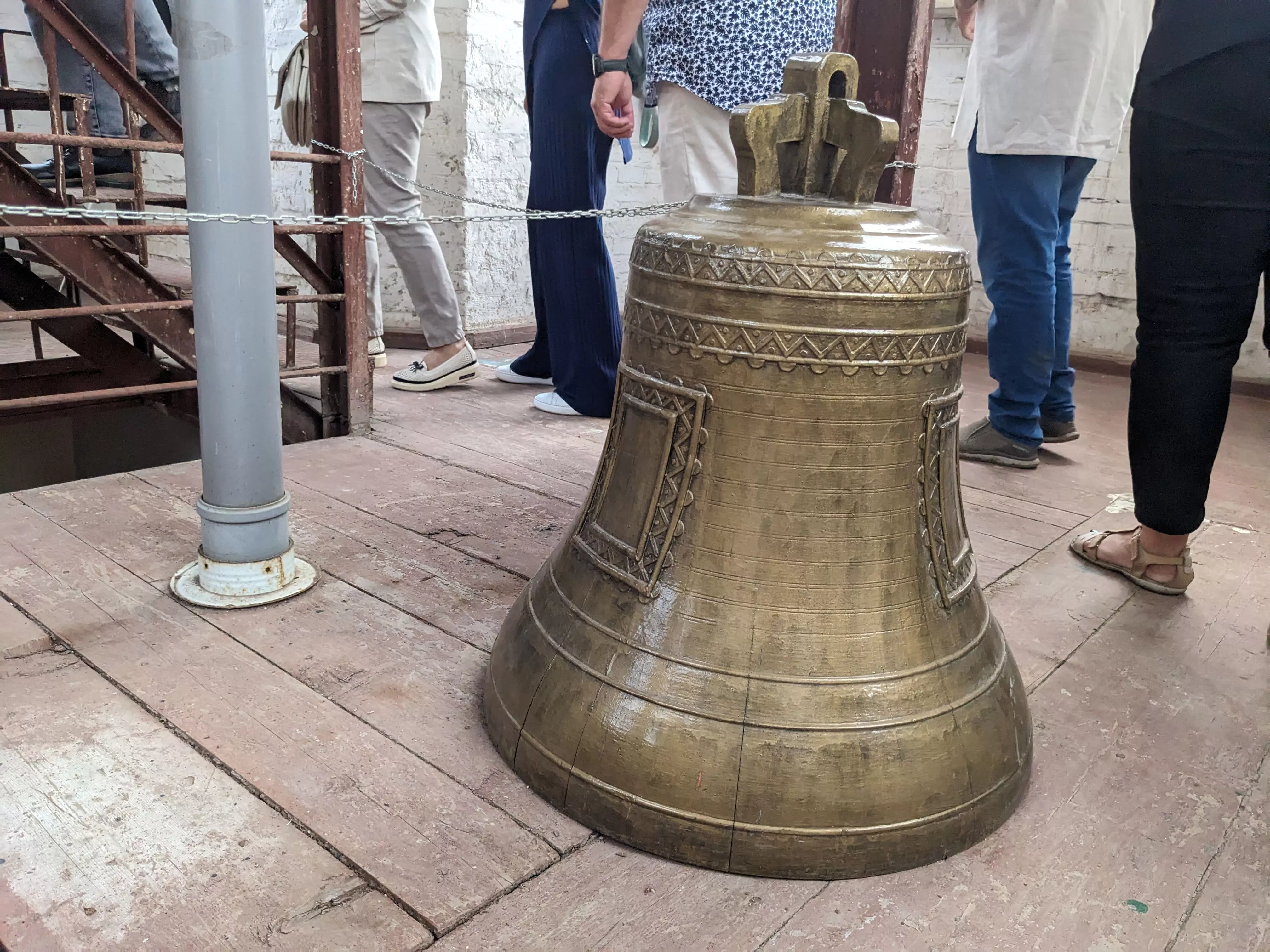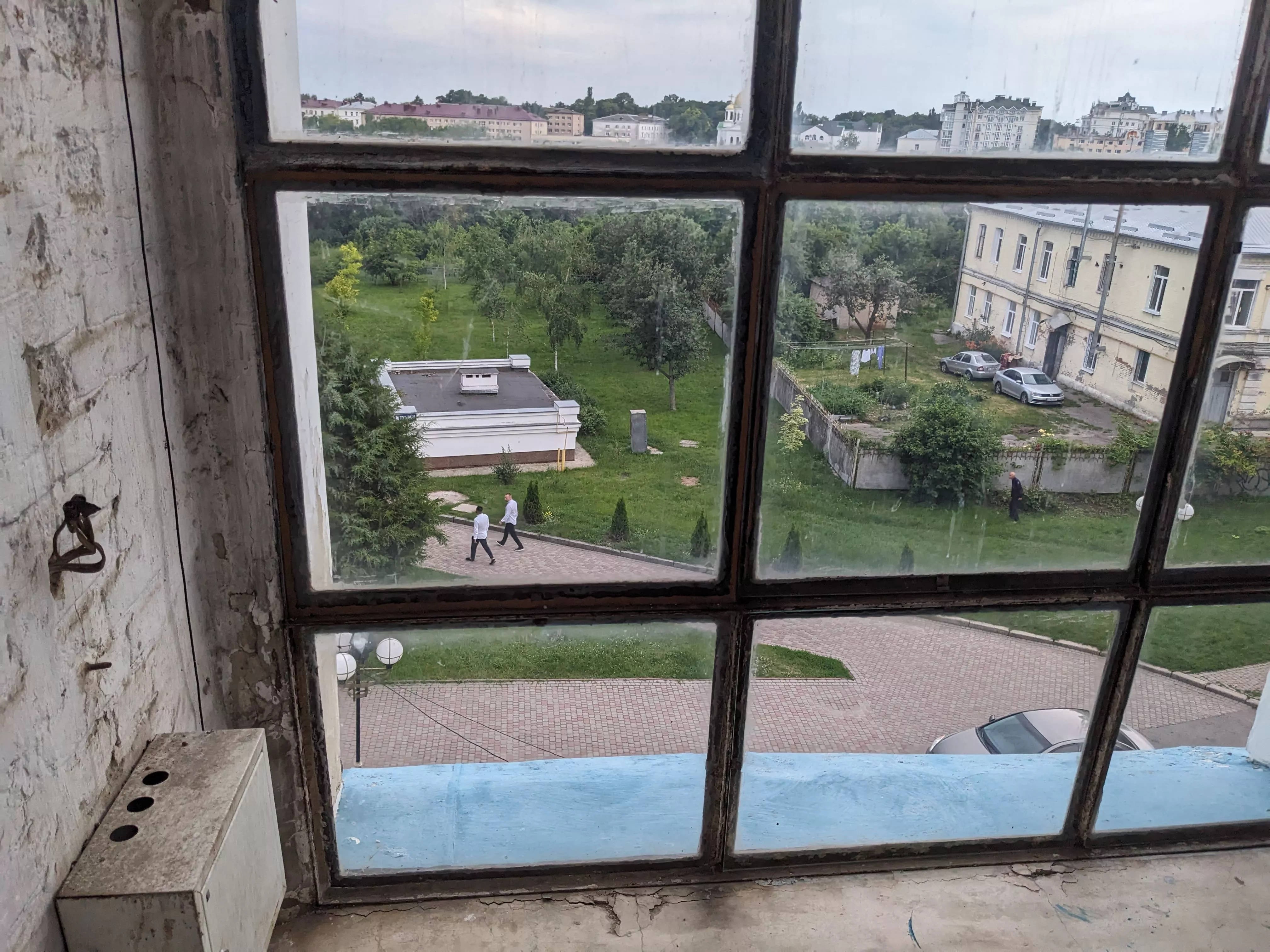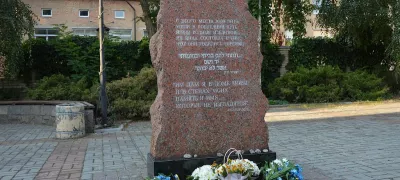
To climb up the bell tower, see the bells up close, ascend narrow stairs that were previously accessible only to the bell ringer and church officials, and enjoy a unique view - these were the opportunities that the residents of Poltava had before Constitution Day.
The first tour was personally conducted by Metropolitan of Poltava and Kremenchuk, Fedir. Journalists were also present for this tour. Visiting the tour is possible only by prior appointment. The cost is a donation for the Armed Forces of Ukraine. Participants receive a safety briefing.

We gather near the bell tower, ready to ascend the hill. People are discussing that there were plans to open the bell tower for visits even before the invasion, but they couldn't allow visitors until the wooden flooring was replaced with a metal one. Metropolitan approaches us and suggests going into the cathedral first.
The people of Poltava still remember how 20 years ago there was an empty field where the cathedral stands today because the Soviet authorities demolished the cathedral in 1935, leaving only the bell tower intact. And they remember the difficulties and scandals that accompanied the construction of the new cathedral in Poltava.
There were several churches in this place. The first one appeared in the 17th century, made of wood, but it was later dismantled and moved to the village of Ivashki, where it continued to serve. And in its place, the Cossack elders built a new one," Metropolitan Fedir explains.
Meanwhile, Bishop Fedir talks about how they managed to protect the site where the cathedral once stood from further development during Soviet times. This incident was described in the memoirs of architect Weinhardt. Local officials wanted to build garages on the site of the destroyed cathedral. Miraculously, a young Weinhardt managed to convince them not to do so.
"Are you an architect or an archimandrite?" the party committee secretary spat at Weinhardt, slammed the door of his Volga, and drove away. But no one else claimed the field where the cathedral was eventually built in 2000.
"The history of restoring the cathedral is not an easy one. The initiator of the restoration was the city head Anatolii Kukoba. He even managed to have the cathedral recognized as a historical monument of significant cultural value. There was supposed to be some state funding, but unfortunately, that didn't work out, and entrepreneurs, so to speak, under the pressure of Anatolii Kukoba, rebuilt this temple," explains Bishop Fedir.

Poltava residents have probably heard the story that the cathedral was supposed to be taller. It was built according to the drawings of architect Valerii Tryhubov to make an exact replica of the previous cathedral. But then something went wrong, and as a result, the cathedral ended up being 10 meters shorter than it was supposed to be.
"But thank God, it exists. By 2004, it already had the external outlines of a cathedral, although there was still a construction site inside. The church services were held in the bell tower, which was handed over to the Ukrainian Orthodox Church of the Kyiv Patriarchate. That was the only Ukrainian community in Poltava at the time! Then the Pokrovska community appeared in Sady-2. There were only two Ukrainian churches in Poltava in the past, the rest belonged to the Moscow Patriarchate," Bishop Fedir explains.
We learn that there is also a lower church in the cathedral, which will undergo repairs and be open to visitors in the future.
We are offered to take a closer look at the iconostasis. It is one of the largest in Ukraine, measuring 18 meters in width and 12.5 meters in height. The iconostasis was carved by masters from Poltava in the style of late Ukrainian Baroque.

We are given some tips on how to better observe the iconostasis:
In the main tier of the iconostasis, there are the central icons: the Savior and the Mother of God. Next to them are important saints, and in our cathedral, they are St. Barbara the Great Martyr, St. Nicholas the Wonderworker, and St. Macarius the Priest-Martyr. By the way, if a saint is depicted holding a cross in their hands on the icon, it signifies their martyrdom, when people testified to their beliefs at the cost of their own lives. The far-right icon in the first tier is usually the icon after which the church is named. The cathedral is called the Uspensky Cathedral, so the icon of the Dormition of the Holy Mother of God should be there (though it is hanging slightly off-center, as it happened).

In the second tier of the iconostasis, there are 12 key feasts depicted, including the Transfiguration of the Lord, the Ascension, the Dormition, and the Nativity of the Mother of God.
In the third tier of the iconostasis, there are 12 apostles depicted. There is an interesting detail - Apostle Peter (the one with the keys) for some reason bears a strong resemblance to the Lviv artist who painted these icons. They say he wanted to paint all the icons resembling himself, but he was convinced to make the saints look older and have different faces. The icon painter agreed, but he still made Peter look similar to himself.

Make sure to look at the very top of the iconostasis when you are in the cathedral - there you will see the coat of arms of Ukraine. It is currently the only iconostasis in Ukraine that incorporates the state symbol of Ukraine.

In the lowest tier of the iconostasis, there are narrative icons. Among them is the icon depicting a Turkish galley with yellow and blue sails, on which for 25 years the Ukrainian hetman Samiylo Kishka rowed as a slave after being captured by the Turks. He refused to convert to Islam, even with promises of a better status, and instead, he sought the help of St. Nicholas. And he succeeded in raising a rebellion and, together with the captive Cossacks, driving the Turkish galley to Kyiv. As a sign of gratitude, Samiylo Kishka built the Church of St. Nicholas the Good (unfortunately, the church did not survive, only the bell tower remains).
On the way to the bell tower, Metropolitan Fedir tells a story that inside its walls, an icon was found in 1991. It means that during Soviet times when everything was being destroyed and demolished, someone decided to save the icon, placed it in a niche in the church, and sealed it. They say there was also a note accompanying it.

We climb to the second floor through a narrow corridor. The first stop is near a peculiar instrument.
"Our bell tower combines religion and science," Metropolitan Fedir explains. "Before you, there is an experimental model: a Ukrainian pendulum instrument invented by Adam Gozhyi, a parishioner of ours and an employee of the Poltava Observatory."

The instrument has been patented, and perhaps it marks the beginning of fundamental science and the study of the Coriolis force, which humans can utilize for their own interests.

We ascend to the next floor, where the bells used to hang in the 18th century. One of them, the Kyzy-Kyrmen bell, was cast by the Cossacks from Turkish cannons. Currently, there is a replica here, while the original bell is kept in the museum. However, you can see the original wooden beams on which the bells used to hang.

"Here is where the bell ringer stood," Metropolitan Fedir narrates. "The sound was very powerful, and it consisted of a specific sequence of tones. People would hear the bell and understand when someone was being buried, when there was a holiday, when the service was starting, or when the Gospel was being read in the church."



One floor above, we see modern bells, cast at the Poltava Locomotive Repair Plant, which used to have a workshop. The bells are equipped with electric hammers and operate automatically. At the beginning of the Russian invasion, they were used instead of sirens until the city's alert system was set up.



The wooden window sills on the observation platform were repaired to maintain maximum authenticity without disturbing anything. From here, there is a beautiful view of the monastery, the university, the cathedral, and the circular square. The bishop says that when the leaves fall in autumn, the view will be even more picturesque. You can also see graffiti on the walls. People who visited the bell tower at different times scratched crosses, but there were also colorful inscriptions like "Oleh Lysyi was here"...

There is one more floor above us, but visitors are currently not allowed there as the structure is still undergoing repairs.

Jokes aside, we all recite the prayer in unison and, with a sense of intellectual enlightenment, descend back to the ground.

вологість:
тиск:
вітер:
0 Comments
To add the comment